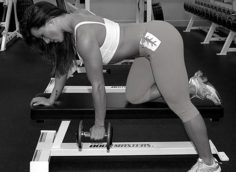While there's been no weightlifter Gallop poll on this, it's probably safe to assume that most lifters think you need to, at least occasionally, hit concentric failure to maximize muscle growth.
There are a million and a half ways to do this, but one of the most popular is drop sets, a.k.a. descending sets. In general, drop sets are where you take a set to muscular failure and then immediately reduce the load by a pre-determined percentage or amount and pump out more reps until you hit failure again.
Depending on your ballsiness, goals, tolerance to pain, and whether you're late for a dentist appointment, you could keep on performing subsequent drop sets until you're curled up on the floor in the fetal position, desperately calling out to mommy or some deity to take away the pain.
But do drop sets work? Do they really maximize muscle growth? Muscle physiologist and T Nation contributor Brad Schoenfeld, along with researcher and Scrabble player's delight, Jozo Grgic, decided to take a look at the studies on the subject of drop sets to see if science supports their use.
Here's a synopsis of what they found, along with some drop set recommendations, lifted from their upcoming paper for The Strength and Conditioning Journal.
Study 1
Researchers found that doing a low-intensity set (50% of 1RM) right after doing 5 high-intensity sets (90% of 1RM) led to a big spike in growth hormone (GH). The trouble is, as Schoenfeld and Grgic point out, recent research on the value of post-exercise GH spurts has shown it to be a virtual non-factor.
Study 2
Participants did a normal strength training routine for 4 weeks, followed by an additional 4 weeks of either drop set training or "normal" training. The drop set group experienced a 2% increase in the cross sectional area of the thigh while the other group experienced a 0.5% decrease.
That sounds big, but the fatal flaw in this study was that they didn't control for training volume, so the increase from drop sets could have just come from doing more work in general.
Studies 3, 4, 5, and 6
I won't bore you. All but one of the studies addressed showed minimal or non-existent benefits, and the one that did, while showing a doubling of the cross-sectional area of the triceps among participants, received a ho-hum from Schoenfeld and Grgic because the findings didn't reach statistical significance.
Despite the disappointing findings about drop sets, they're one of those training methods that just feels right. Deep down, you kinda-sorta know they work, regardless of what some pasty researchers say. Besides, the failure of these studies to come up with positive findings could very well be from flaws in study design and not because of any failings of drop sets.
Even Schoenfeld and Grgic give you the feeling they want to believe that drop sets work, but of course they won't offer any conjectures because PhDs don't do conjecture.
Schoenfeld and Grgic did, however, offer some recommendations on how drop sets could best be employed, while cautioning that their continuous use over time might be detrimental because of possible decreases in insulin-like growth factor and testosterone, both of which are necessary for muscular growth:
- Drop Set Weight: The load is commonly reduced by 20-25% with each drop. You can use smaller drops, but that would make it harder to reach fatigue. You can, of course, use larger drops (5 to 10%), but that would reduce the number of reps you can do.
- Rest Intervals: Minimal. Just enough time to change the weight and get in position for the next set.
- Training Volume: They recommend one, two, or three drops in load. They just don't know if there's any benefit to doing more than three drops.
- Tempo: 1 to 3 seconds on the concentric (lifting) and eccentric (lowering). Slower tempos would reduce the number of reps and defeat the purpose (increased volume).
- Exercise: They say that both multi-joint and single-joint exercises can be used, but from a practical perspective, it works better with single-joint movements, particularly if you don't have a training partner to unload your weights.
- Frequency: They give an okay to using drop sets multiple times throughout a training week, but they warn that continued use might lead to overtraining.
- Schoenfeld B et al. Can Drop Set Training Enhance Muscle Growth? Strength Cond J. 2018 Dec;40(6):95-98





